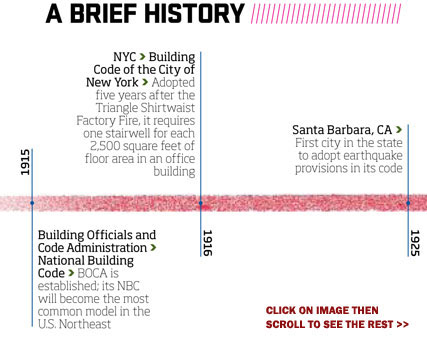Code Green
California
Building Codes 101 Although the terms are often used interchangeably in casual conversation, codes, standards, and rating systems are not the same. Codes A building code establishes minimum requirements for a building within a given jurisdiction to ensure the health, safety, and welfare of its occupants. Codes are written in normative, or mandatory, language and with the pertinent regulatory and administrative information so that officials can enforce them. Adoption and implementation of building codes can vary from state to state. In some, the state legislature and regulatory agencies adopt and implement building codes across all jurisdictions statewide. In others, city councils, town councils, county boards, and pertinent local agencies are responsible for the adoption and implementation of their own codes. Standards A standard offers "how-to" guidelines that describe current best practices. Although more technical in nature, and without as much enforcement and legislative wording, they still tend to be written in normative language because they are often referenced by codes. Ratings A rating system is usually characterized as a voluntary program with a high number of options that encourage developers to adopt innovative, beyond-code-minimum approaches. Rating systems are not written in normative language because they are intended as an "engagement tool" to encourage dialogue and experimentation, says Jeremy Sigmon, USGBC's manager of building codes advocacy. A qualified third-party inspector—not a code official—evaluates a building project to determine if it is eligible for certification under such a program. |
Always on the cutting edge, California enacted the first statewide mandatory green code in the country, the 2010 California Green Building Standards Code, or the CALGreen for short. It forms a separate chapter—Part 11—of the California Code of Regulations, Title 24, otherwise known as the California Building Standards Code.
California's green-code effort began in 2007, when then-Governor Arnold Schwarzenegger asked the California Building Standards Commission to work with the appropriate state agencies to adopt sustainable building standards for residential, commercial, and public buildings. The developers began with Collaborative for High Performance Schools (CHPS); California Green Builder; LEED; Green Globes; Scottsdale Arizona Checklist; Build It Green; U.C. Berkeley Green Building Baseline; and a draft version of the American Society of Heating, Refrigerating and Air Conditioning Engineers' (ASHRAE) Standard 189.1 (see below). The 2008 version went into effect August 2009 as a voluntary option. The 2010 version became mandatory statewide on January 2011.
The new code covers the typical categories delineated by the green voluntary rating systems—site issues, energy efficiency, water efficiency and conservation, material conservation and resource efficiency, and environmental quality.
Although mandatory across California for all new construction, CALGreen is far from monolithic. It actually consists of three levels: the base code is required but individual jurisdictions can implement more stringent strategies by adopting tier 1 or, the most demanding, tier 2. If a jurisdiction selects one of these tiers, the project must satisfy prerequisite measures for the specified tier, any additional measures within that tier that the jurisdiction deems necessary due to local conditions, and a specified number of elective measures associated with that tier.
Design professionals who have already been applying green strategies to meet one of the voluntary rating systems in California do not appear concerned about fulfilling CALGreen's technical requirements. "If you are accustomed to designing to LEED, it is business as usual," reports Marsha Maytum, principal of Leddy Maytum Stacy Architects in San Francisco.
The biggest challenge green-building-savvy design professionals currently seem to have regarding the new code is determining what options a particular jurisdiction has selected. "This is still evolving," says Marc J. Cohen, director of sustainable design at MVE Institutional in Irvine, California.
Enforcement is also still a work in progress. Like design and building professionals, building inspectors have been receiving training on the new requirements. Cohen anticipates that there will need to be a "bit more of a partnership between the building officials and the design and construction side" as code officials figure out how to inspect the first wave of projects falling under the new regulations.
Click on image to see more details |









